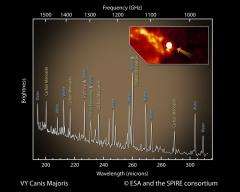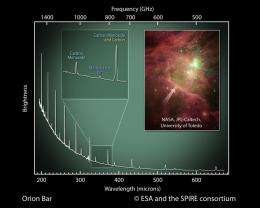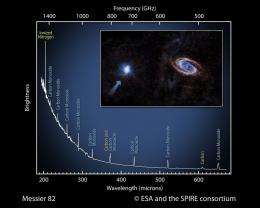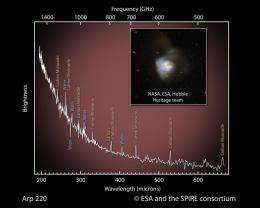Herschel takes a peek at the ingredients of the galaxies

(PhysOrg.com) -- The European Space Agency has today released spectacular new observations from the Herschel Space Observatory, including the UK-led SPIRE instrument. Spectrometers on board all three Hershel instruments have been used to analyse the light from objects inside our galaxy and from other galaxies, producing some of the best measurements yet of atoms and molecules involved in the birth and death of stars.
The SPIRE Fourier Transform Spectrometer (FTS), which covers the whole submillimetre wavelength range between 194 and 672 microns, will be invaluable to astronomers in determining the composition, temperature, density and mass of interstellar material in nearby galaxies and in star-forming clouds in our own galaxy.
Professor Keith Mason, Chief Executive of the Science and Technology Facilities Council (STFC), which provides the UK funding for Herschel, said “Herschel has once again returned some spectacular indications of what is to come. This wealth of new data exists because of the dedication and skill of the scientists working on this project and will vastly expand our knowledge of the life cycle of stars.”
Professor Matt Griffin of Cardiff University, who is the SPIRE Principal Investigator, said: “Some trial observations have been made during initial testing of the spectrometer, and it is clear that the data are of excellent quality, and even these initial results are very exciting scientifically, especially our ability to trace the presence of water throughout the Universe. The spectrometer was technically very challenging to build, and the whole team is delighted that it works so well.”

Professor Glenn White, of the Open University and STFC’s Rutherford Appleton Laboratory, and an expert in the field of molecular astronomy for which the SPIRE spectrometer is designed, said: "The exquisite sensitivity and quality of these early data reveal spectacular spectroscopic signatures that show the diversity and complexity of the birth processes common to the formation of star and planets. Herschel is going to help us trace the evolution and life of stars, to map the chemistry in our galactic neighbourhood, and allow us to detect water and complex molecules in distant galaxies."
Professor Mike Barlow of University College London, who will use the SPIRE instrument to study the material ejected into space by stars near the end of their lives, said: “The unprecedented spectral range and the wealth of detail revealed by the SPIRE spectrometer, in a hitherto almost unexplored region of the spectrum, promises to revolutionise our understanding of the formation of molecules and dust particles during the final stages of the lives of stars. These dust particles go on to play a crucial role in the formation of new stars and provide the raw material for the planetesimals and planets that form around them."
Figure 1 shows part of the SPIRE spectrum of VY Canis Majoris (VY CMa), a giant star near the end of its life, which is ejecting huge amounts of gas and dust into interstellar space, including elements such as carbon, oxygen and nitrogen (which form the raw material for future planets, and eventually life). The inset is a SPIRE camera image of VY CMa, in which it appears as a bright point-source near the edge of a large extended cloud. The spectrum is amazingly rich, with prominent features from carbon monoxide (CO) and water (H2O). More than 200 other spectral features have also been identified, many due to water, showing that the star is surrounded by large quantities of hot steam. Observations like these will help to establish a detailed picture of the mass loss from stars and the complex chemistry occurring in their extended envelopes.

Figure 2 is a spectrum of one position on the Orion Bar, part of the Orion nebula in which the gas on the edge of the nebula is partly ionised by intense radiation from nearby hot young stars. The inset shows a near infrared picture from NASA’s Spitzer Space Telescope. The SPIRE spectrum has many features from CO, appearing as the dominating narrow lines, seen here for the first time together in a single spectrum. These mean that the entire spectrum is observed at the same time and calibrated together. The brightness of the spectral features will allow astronomers to estimate the temperature and density of interstellar gas. The spectrum also shows the first detection of an emission feature from the molecular ion methylidynium (CH+), a key building block for larger carbon-bearing molecules. This and similar regions are large, and the SPIRE spectrometer’s will be extremely powerful in characterising how the gas properties vary within such sources.
Figure 3 shows a SPIRE spectrum of Arp 220, a galaxy 250 million light years away from Earth with very active star formation triggered when two large spiral galaxies collided to produce the complex object we see today. Arp 220 is an important template for understanding even more distant galaxies and galaxy formation in the early universe. The spectrum shows many emission features of CO, and H2O features are seen both in emission and absorption. The inset is an optical image of Arp 220 made with the Hubble Space Telescope.
Figure 4 shows the spectrum of Messier 82 (M82), a nearby galaxy (only 12 million light years away) with very active star formation. It is part of an interacting group of galaxies including the large spiral M81. The accompanying image (inset) is a spectacular three-colour composite picture of the two galaxies made with the SPIRE camera, showing material being stripped from M81 by the gravitational interaction with M82. The SPIRE spectrum of M82 shows strong emission lines from CO over the whole wavelength range, as well as emission lines from atomic carbon and ionized nitrogen.

The SPIRE FTS observations were carried out as part of the performance verification of the observatory. The scientific rights of some of these observations are owned by Key Programme consortia: for Arp 220 and M82, the Nearby Galaxies consortium lead by C. Wilson; for VY CMa the MESS consortium led by M. Groenewegen; for the Orion Bar, the Evolution of Interstellar Dust consortium led by A. Abergel.
Provided by Science and Technology Facilities Council (news : web)



















